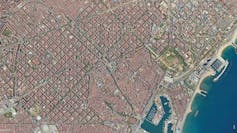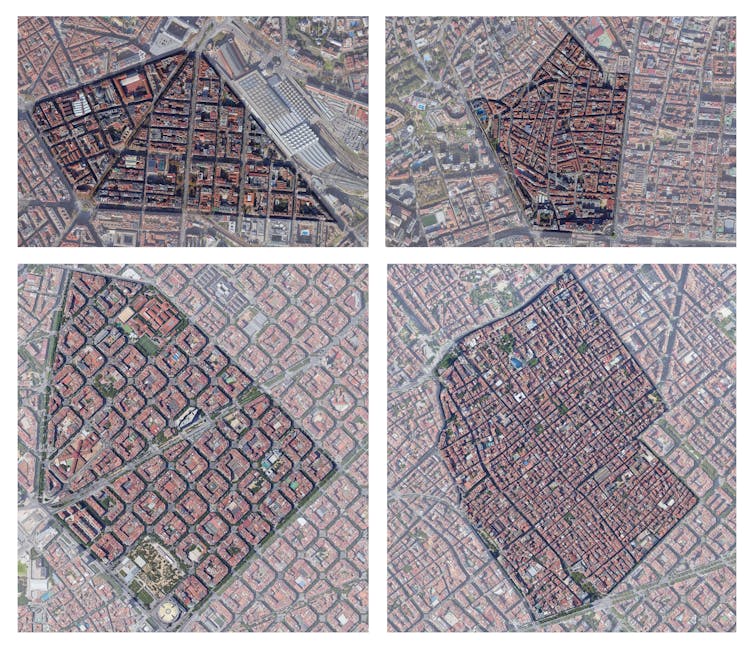|
Getting your Trinity Audio player ready...
|
As of 2007, most humans live in cities. Though this is a relatively recent trend, many of our settlements contain street, block, and building patterns that have developed over centuries. These patterns – which collectively make up what we call “urban form” – are far from a neutral backdrop: they influence who lives where, what businesses find footholds in which locations, and what makes some areas more diverse than others.
“Bottom-up” and “top-down” are terms which are often used to pin down the two ends of the vast range of urban form. Bottom-up refers to neighborhoods which develop naturally and gradually, without a strict masterplan guiding their development. Top-down, on the other hand, refers to urban form that is designed by singular authors, with much tighter controls over, and ideals around, how it should develop over time.
If we look at bottom-up neighbourhoods from a bird’s eye view, we tend to see a variety of block sizes, street widths and public spaces, and often maze-like street patterns. Top-down areas, by comparison, tend to be less varied, with clear evidence of their authors’ vision and values regarding urban geometry and the nature of public space – grid systems and sweeping boulevards abound. Many cities have bottom-up and top-down neighourhoods existing side by side, legacies of different political and socioeconomic eras.
Cities also reflect the values of time, place, and history. Today there are extensive discussions of bottom-up development and how it fosters communities and neighbourhood identity, while the lasting imprints of top-down regimes are still clearly visible in contemporary cities around the world.
For centuries, architects, planners and philosophers have suggested that bottom-up areas of cities tend to be more inclusive than top-down ones, supporting a wider range of economic classes. However, decisively proving such a theory has proved challenging.
How the built world shapes demographics: two theoretical approaches

The link between urban form, class and economic diversity follows two lines of thought.
The first is an extension of ecology. In natural habitats that have developed slowly over time – through bottom-up processes – we tend to observe a wide range of species. However, in planned habitats – built much more rapidly in a top-down manner – this kind of richness is often markedly absent. Slow growth tends to produce more intricacy and diversity, and this idea is often extended to theories of urban form.
The second line of thought is economic. Consider the diversity of public spaces in bottom-up districts – different sized streets, alleyways, squares, parks, courtyards, and so on. This variety of public spaces creates different qualities of light and air, as well as a wide range of favourable and less favourable conditions.
A more varied real estate market should, in theory, emerge as a byproduct of this diversity: a dark, poorly ventilated apartment is cheaper than a bright, airy one; a dwelling overlooking a pleasant square is more marketable than one next to a narrow alley. These varied spaces can host a varied population – a range of different ages, household sizes and income levels, all living cheek to jowl alongside one another.
In a top-down neighbourhood such variety is often absent, as buildings, streets, and public spaces tend to be more uniform. This homogeneity should, in theory, limit population diversity.
Real world examples: Madrid and Barcelona
In late 2021, we conducted research into the relationship between urban form and housing. We looked at two districts in Barcelona and two in Madrid, with one bottom-up and one top-down in each city, homing in on areas with similar average real estate values. The neighbourhoods examined were Bellas Vistas and Palos de la Frontera in Madrid, and Vila de Gracia and Nova Esquerra de l’Eixample in Barcelona.
Curiously, our research both confirmed and subverted the presumed theoretical link between urban form and housing stock, and the presumed supremacy of bottom-up over the top-down areas in fostering economic diversity.

Our main finding was that the bottom-up districts we looked at had, overall, more small-scale apartments. The reason is simple: they had more small-scale buildings, built on small-scale plots. Once divided into apartments, this produces small apartments – homes in the bottom-up areas were 10% to 23.1% smaller than their top-down counterparts. This also made their real estate markets for small homes more competitive, and therefore more affordable.
However, our study showed there is nothing inherently magical about bottom-up areas. Their more intricate housing stock has little to do with the layout of streets and blocks, and a lot to do with how that land is built upon.
Plot size appears to be the deciding factor: the districts with greater numbers of small buildings built on small plots supported a denser and more affordable housing stock, regardless of whether they were top-down or bottom-up.
Older bottom-up areas seem to naturally lend themselves to having more small-scale plots. This is likely due to the incremental development of these areas, and the complex land ownership patterns that developed as a result. However, there is no reason why a top-down area cannot be designed to replicate these characteristics.
Implications for the housing crisis
Governments seeking to rein in housing markets can take action to encourage development on a smaller scale. One rather blunt, though potentially fruitful, method is limiting ownership of urban land by a single individual or corporation, or limiting the footprint and size of non-public buildings that can be built within a city.
Although it applies to agricultural land, the limitation of private ownership to 50 acres per person in Sri Lanka is a useful case study here.
Even in countries like the United States, where property rights are wielded in objection to such arguments, there is a longstanding debate on the fundamental necessity of land ownership limitations in maintaining a functioning capitalist system.
As housing crises rage across the world, many cities are in dire pursuit of a more affordable, more varied, and more inclusive housing stock. It is increasingly clear that urban policies aiming to achieve this solely by addressing real estate development are falling woefully short of their aims on a global scale.
What our research indicates is that deeper, more structural approaches may be worth considering – approaches that not only address the physical form of the city, but also the ownership patterns that underpin it. Approaching urban land ownership and architecture on a smaller scale may hold potential that is not yet being used in full.



